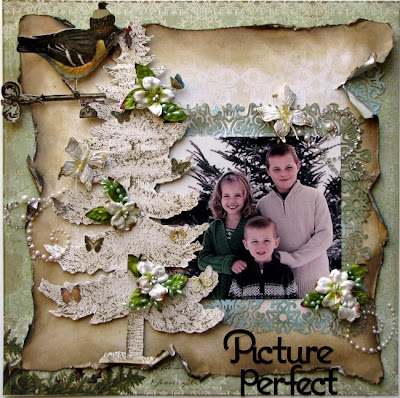 I've written step-by-step instructions explaining the way I distress my paper. I know everyone has their own methods and tools they like use so if you'd like to share your distressing techniques, please feel free!
I've written step-by-step instructions explaining the way I distress my paper. I know everyone has their own methods and tools they like use so if you'd like to share your distressing techniques, please feel free!Step 1: Tear the paper around all 4 edges to get a textured edge.
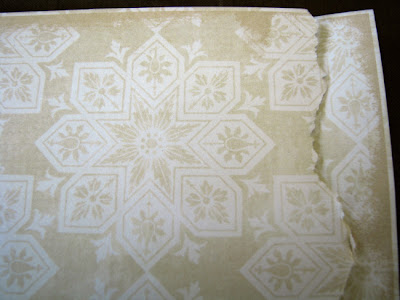
Step 2: This is what is looks like when 4 edges have been torn.
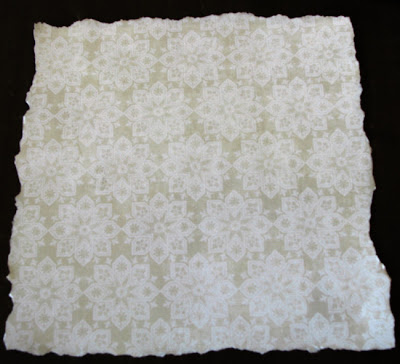 Step 3: Next take a distress tool of choice. Honestly the foot sanding tool shown on the left of the photo below is my favorite tool and available at the $1.00 store. (I have 4 of them in lots of pretty colors!)
Step 3: Next take a distress tool of choice. Honestly the foot sanding tool shown on the left of the photo below is my favorite tool and available at the $1.00 store. (I have 4 of them in lots of pretty colors!)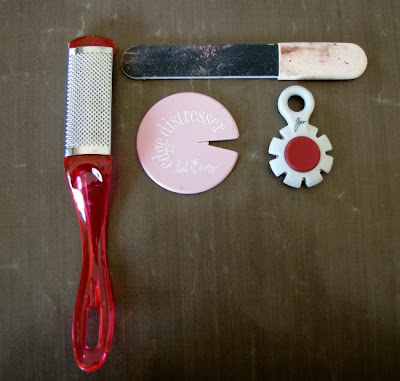
Step 4: Use the foot sanding tool and rub around all the edges, it shapes them nicely and turns up the edges for texture. Be aware, there is going to be lots of paper dust flying around! I wish I would be able to share a better photo of this part. As you can probably see I'm using a back and forth motion, that way that paper will start to curl up.
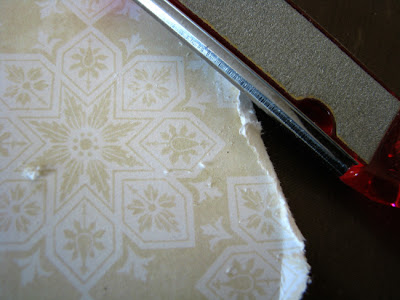
Step 5: If you rip parts of the paper, it's ok! It gives the paper character. I would recommend a few tears on the page.
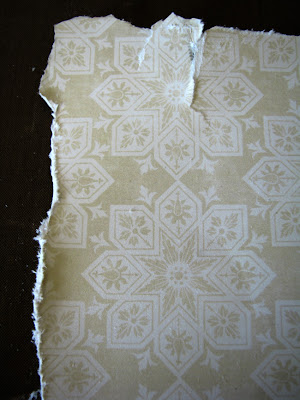 Step 6: Time to pick some ink. Tim Holtz distress inks are my must-have go-to inks (and I will be adding to my stash because all the new colors are in the store.) These are the 3 colors I almost always use for distressing: Antique Linen, Walnut Stain and Black Soot. Along with my blending tools.
Step 6: Time to pick some ink. Tim Holtz distress inks are my must-have go-to inks (and I will be adding to my stash because all the new colors are in the store.) These are the 3 colors I almost always use for distressing: Antique Linen, Walnut Stain and Black Soot. Along with my blending tools.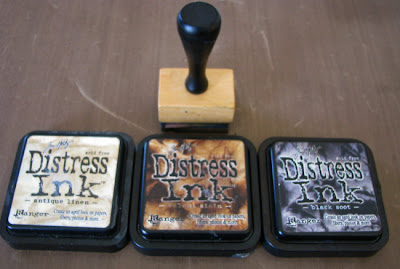
A great tip I have is to make some color cards or tags. Just swipe some ink on a spot and write the name of the ink near it. You can hold the card to your project to see what colors coordinate. This will save a lot of time and guess work.

Step 7: Start with the lightest color, Antique Linen, and rub from the edge to about 2 inches into the paper.
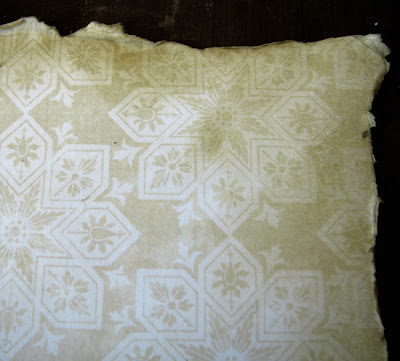 Here's an example of how it looks when the entire piece is inked with the first color. After this I go back with my sanding tool and rub it on the edges again. I also use my palm to bend up pieces.
Here's an example of how it looks when the entire piece is inked with the first color. After this I go back with my sanding tool and rub it on the edges again. I also use my palm to bend up pieces.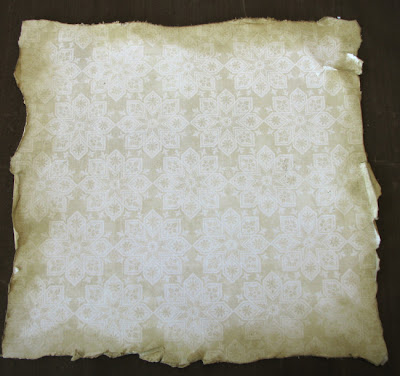
Step 8: Next take the 2nd color, Walnut Stain, and go from the edge to about 1 inch into the paper, really working it into the edges and creases.
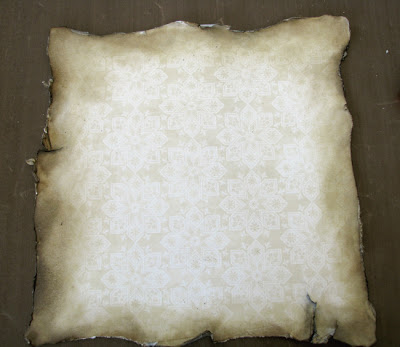
Step 9: Now, take the Black Soot ink and do just the very edges (this is how I get the burnt effect), get into the torn edges really well too.
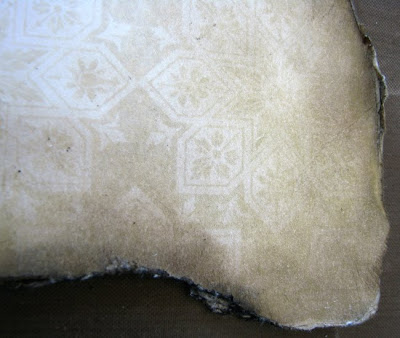
See how the black looks in the torn part.
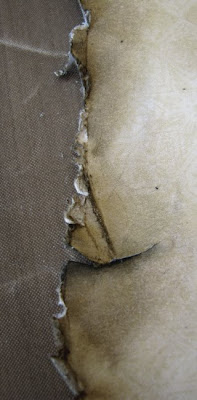
Step 10: When you are finished the edges should look like this. To begin the layout, I centered the distress paper on a piece of pattern paper from Webster's pages.
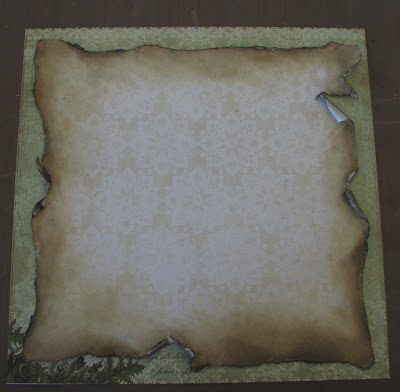
By cutting out decorative elements from the papers I can embellish the layout. The pretty white butterflies and flowers are from a Prima vine. I cut the vine apart and used pop-dots to hold them down. I then painted over the top of the butterflies and flowers with some sparkly shimmerz product.
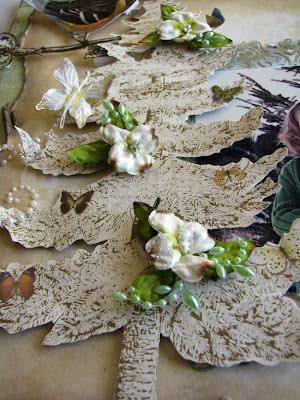
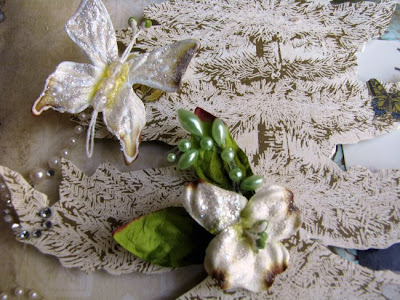 For the hand cut bird shape, I used double popdots (a popdot stuck to a popdot) to give it lots of dimension. Also gave the bird a coat of glossy accents to perk him up a bit.
For the hand cut bird shape, I used double popdots (a popdot stuck to a popdot) to give it lots of dimension. Also gave the bird a coat of glossy accents to perk him up a bit.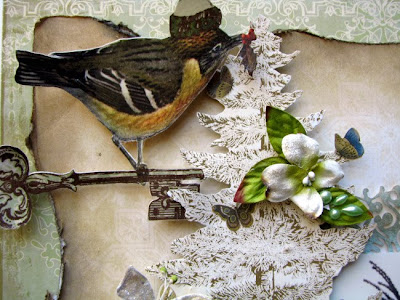 All the Webster's Pages papers, Prima flowers, Prima bling are from BlueMoon Scrapbooking. The also carry the Tim Holtz Distress ink new colors and the older colors.
All the Webster's Pages papers, Prima flowers, Prima bling are from BlueMoon Scrapbooking. The also carry the Tim Holtz Distress ink new colors and the older colors.Please share how you distress your paper.
Have a wonderful week!
~Melanie














HOLY SMOKES Melanie!!! wow wow wow wow wow wowowwwwwwwwwwwwwwwwww!! i never would have thought to use a foot sanding tool!!! that is genius!! thanks for the tip!!! and i loveeeeeeeeeeeeeeeeeeeeee this lo!!!!! that tree is GORGEOUS! :):):):):):):):):):):):):):):):):):):):):):):):):):):):):):):) I still use the heidi swapp distresser! :):):):):):):):):):):):):):):):):):):):):):)
ReplyDeleteI am SO happy you've shared this technique with all of us! I can't believe how it really looks like you've burned the edges yet there were no flames involved....wow! Fabulous tutorial Melanie!
ReplyDeleteAbby:)
Wow! LOVE that you shared this techniques with us!! I would never have thought about a foot sanding tool!! lol LOVE the mix of Inks too! Looks like I need to do some more shopping!!
ReplyDeleteThank you for sharing the secret to your great look!! And I love the idea of the sample color cards for the ink - why have I never done that?? No good answer but it's at the top of my list to do today!
ReplyDeletewow!! thanks so much for sharing that technique! that is one beautiful layout, Melanie!!!! I love the tree and all the litte details you added to it! I also love how you did the bird and the key! just an amazing job!
ReplyDeleteGood idea on making color cards!! I will have to do that! I also use Tim Holtz distress inks and can't wait to try out some of the new colors!
great post!
B
thanks for sharing the technique-I now know my problem I had was my TOOLS and I def have some of the foot thingees upstairs somewhere-who knew they'd work in scrappin'???
ReplyDeleteSimply stunning! Thanks for sharing.
ReplyDeleteFoot sanding tool! Genius!!
ReplyDeleteThanks!!
How kind of you to walk everyone through your distressing techniques. Your work is gorgeous!! I am wondering if my ped egg will work...just kidding, lol! ;)
ReplyDeleteThere are no words for this...*drool*
ReplyDeleteI'm like over stimulated now! Amazing!
Wow, what a great technique!!
ReplyDelete